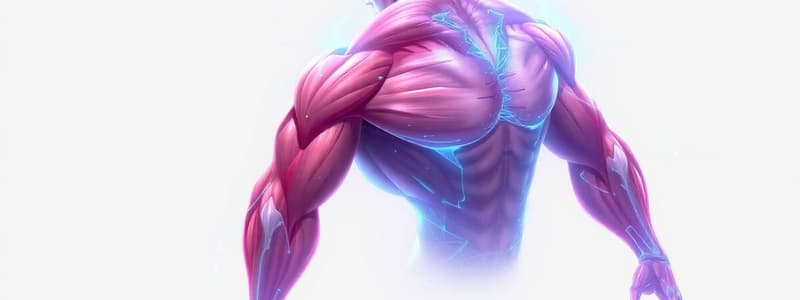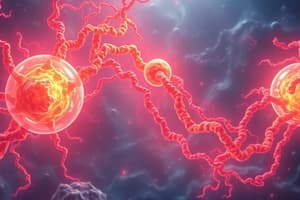Podcast
Questions and Answers
Which type of muscle is characterized as involuntary and striated, found in the walls of the heart?
Which type of muscle is characterized as involuntary and striated, found in the walls of the heart?
- Cardiac muscle (correct)
- Voluntary muscle
- Smooth muscle
- Skeletal muscle
What is the main distinction between one joint muscles and two joint muscles?
What is the main distinction between one joint muscles and two joint muscles?
- One joint muscles are always voluntary, whereas two joint muscles are always involuntary.
- One joint muscles affect only one joint, while two joint muscles affect two joints. (correct)
- One joint muscles do not exert force.
- One joint muscles are typically larger than two joint muscles.
What role does the brachialis muscle play when performing a bicep curl?
What role does the brachialis muscle play when performing a bicep curl?
- Antagonist during elbow flexion
- Agonist during elbow flexion (correct)
- Stabilizer during elbow extension
- Prime mover for forearm supination
Smooth muscles are controlled by which part of the nervous system?
Smooth muscles are controlled by which part of the nervous system?
Which classification of muscles primarily facilitates the motion of moving a joint in the opposite direction?
Which classification of muscles primarily facilitates the motion of moving a joint in the opposite direction?
What is the correct order of muscle attachment in relation to movement?
What is the correct order of muscle attachment in relation to movement?
What type of muscle provides the force needed to move the skeletal levers?
What type of muscle provides the force needed to move the skeletal levers?
Which of the following is not a characteristic of skeletal muscle?
Which of the following is not a characteristic of skeletal muscle?
What is the primary role of synergist muscles during movement?
What is the primary role of synergist muscles during movement?
Which of the following describes an eccentric contraction?
Which of the following describes an eccentric contraction?
In the context of muscle roles, which example best illustrates a neutralizer action?
In the context of muscle roles, which example best illustrates a neutralizer action?
Which contraction type occurs when holding a weight in a fixed position with no movement at the joint?
Which contraction type occurs when holding a weight in a fixed position with no movement at the joint?
During knee extension, which part of the quadriceps primarily shortens to create movement?
During knee extension, which part of the quadriceps primarily shortens to create movement?
Which of the following defines an isokinetic contraction?
Which of the following defines an isokinetic contraction?
Which scenario exemplifies a situation where co-contraction occurs?
Which scenario exemplifies a situation where co-contraction occurs?
What is the key characteristic of isotonic contractions?
What is the key characteristic of isotonic contractions?
Flashcards are hidden until you start studying
Study Notes
Muscle Function Terminology
- Muscle Roles: Muscles can be classified based on their role in movement
- Agonist/Prime Mover: Muscle causing the desired movement
- Antagonist: Muscle opposing the movement caused by the agonist
- Synergist: Assists the agonist by either:
- Enhancing the movement
- Neutralizing unwanted movements
- Stabilizing a joint during movement
- Co-contraction: Simultaneous activation of agonist and antagonist muscles
- Muscle Types: Muscles can be classified by the type of movement they produce
- Isotonic: Muscle tension remains constant while the muscle length changes
- Concentric: Muscle shortens as it contracts (origin and insertion move closer)
- Eccentric: Muscle lengthens as it contracts (origin and insertion move farther apart)
- Isometric: Muscle contracts but there is no change in length
- Isokinetic: Muscle contracts at a constant speed. Requires specialized equipment
- Isotonic: Muscle tension remains constant while the muscle length changes
Muscle Classification
- Skeletal Muscle: Voluntary, striated muscles responsible for moving bones
- Origin: Attachment point that moves the least, usually more proximal
- Insertion: Attachment point that moves the most, usually more distal
- Cardiac Muscle: Involuntary, striated muscle found in the heart (myocardium)
- Self-contracting but its rhythm is regulated by pacemaker cells
- Smooth Muscle: Involuntary, non-striated muscle found in internal organs (bowels, vessel walls)
- Controlled by the autonomic nervous system
Muscle Classifications by Joint Involvement
- One-Joint Muscle: Affects a single joint only (e.g., vastus medialis)
- Two-Joint Muscle: Affects two joints (e.g., rectus femoris, biceps)
- Multi-Joint Muscle: Affects multiple joints (e.g., finger flexors)
Examples of Muscle Roles and Movements
-
Brachialis: Originates on the humerus, inserts on the ulna
- Agonist: Elbow flexion
- Antagonist: Elbow extension
-
Biceps Brachii: Prime mover for elbow flexion when the forearm is supinated
- Synergist: Muscles that might assist include the brachialis and brachioradialis
-
Rotator Cuff: Stabilizes the shoulder during movements involving the deltoid
- Fixator: Contracts to maintain the position of the humerus while other muscles move it
-
Abdominals vs. Back Extensors:
- Bending down and touching toes involves a combination of both muscle groups
- Abdominals flex the torso, while the back extensors extend it.
Studying That Suits You
Use AI to generate personalized quizzes and flashcards to suit your learning preferences.



